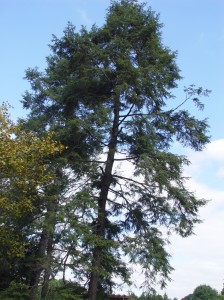Tip of the Week — 4/27/09
Posted in Gardening Tips on April 27 2009, by Sonia Uyterhoeven
Woolly Adelgid
 Sonia Uyterhoeven is Gardener for Public Education at The New York Botanical Garden.
Sonia Uyterhoeven is Gardener for Public Education at The New York Botanical Garden.
 Who’s afraid of the hemlock woolly adelgid? Certainly, many gardeners in the Northeast. Like many pests that plague us, these little creatures were introduced from abroad. In their homeland (Japan) they are kept in check by a type of ladybug that is a natural predator. Here in the United States, though, the woolly adelgid has free range. The only natural challenge it faces is extreme temperatures—once the thermometer drops below 23°F or -5°C, the mortality rate of these fluffy little critters rises.
Who’s afraid of the hemlock woolly adelgid? Certainly, many gardeners in the Northeast. Like many pests that plague us, these little creatures were introduced from abroad. In their homeland (Japan) they are kept in check by a type of ladybug that is a natural predator. Here in the United States, though, the woolly adelgid has free range. The only natural challenge it faces is extreme temperatures—once the thermometer drops below 23°F or -5°C, the mortality rate of these fluffy little critters rises.
So what is hemlock woolly adelgid and why should we be concerned? This pest spends most of its life protected under its telltale fluffy white secretion. You probably have seen it cover the branches of hemlocks. It plants itself at the base of the needles and slowly sucks the sap—and life—out of a tree. This can take anywhere from 1 to 15 years, depending on the tree and environmental situations. While many pests target unhealthy and, therefore, susceptible trees, this pest prefers healthy ones.
For those of you who have grown up on the East coast, as I have, you will appreciate the importance of the Eastern hemlock (Tsuga canadensis) in the landscape. For the homeowner, it is one of the few conifers that make an outstanding addition to a shady border. It has delicate foliage, it can withstand hard pruning, and its lower branches often reach down to the ground, creating a nice, full specimen. It is an important screening and landscape plant.
What you may not have thought about is the important role that it plays in the ecosystem. This shade-tolerant tree grows slowly into giants in the forest, creating cool, shaded areas by stream and river beds that allow many fish and aquatic invertebrates to thrive.
To learn what you can do to help your hemlocks fight the woolly adelgid…
So what can you do to give your hemlocks a fighting chance? The conventional way of dealing with hemlock woolly adelgid is to spray the hemlock twice a year with either an insecticidal soap or horticultural oil. When doing this, make sure that you get good coverage of the tree by spraying both sides of the branches; remember that you are trying to suffocate the insect. This is done in April/May and again in September/October when the pest is in its crawler stage (moving around). When spraying with horticultural oil, make sure that the temperature and humidity is not too high, otherwise you can burn the plant.
Another approach that is becoming popular is to inject the soil around the tree with a chemical called imidacloprid (trademark Merit® or Marathon®). It is best to do a shallow subsurface injection around the base of the tree. This should be done in early fall. Often it takes two years for this treatment to take effect. Then you don’t need to repeat the application for another 2-4 years. Often in this situation, hemlocks still need to be treated with horticultural oil for mites and scale, which often attach the weakened trees. This method would not be appropriate near a stream or in places such as Long Island where groundwater issues are paramount.
The final method is to inject the tree trunk with a systemic. The drawback of this approach is that the imidacloprid doesn’t always get evenly distributed throughout the tree and you can damage the trunk of an already weakened tree.
What is always true in this situation is that good horticultural practices help. They will not do anything to eradicate the pest, but they will help support the tree while it is trying to defend itself from these thirsty little vampires. Hemlocks do not like drought in any circumstances—keep them well-watered in summer and fall. Also do not fertilize your hemlocks if they are under attack. You will only be forcing new growth when the tree should be conserving its energy. Finally, if there is a serious pest problem on anything in your garden, it is better to address it sooner rather than later.


Can anything be done to encourage new growth in damaged areas of hemlocks?